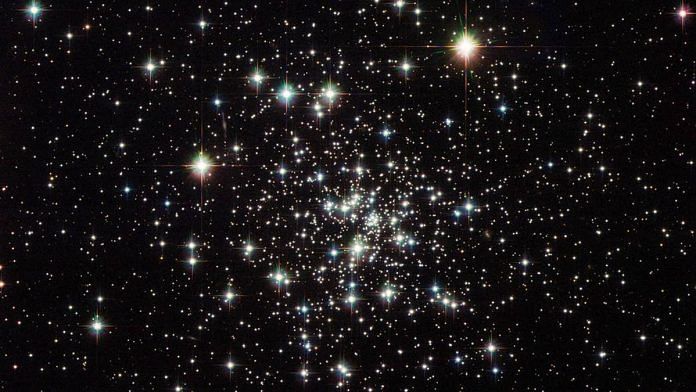Bengaluru: Orbiting in the outer halo of the Milky Way is an unusual and unique globular cluster of stars known as Palomar 5.
This star cluster is characterised by two unique and mysterious features — a low mass of stars as compared to other star clusters, and two long streaming tails of stars ejected from the cluster that extend outwards to much longer distances than other typical star tails.
Why the cluster has these features has remained a mystery, and whether it was born this way with a low mass or evolved to be so has been unclear so far. But according to a new theory from an international team of astrophysicists, the reason is because the cluster has more black holes than usual, enhancing the process of tail formation.
They predict that Palomar 5 will dissolve as a 100 per cent black hole cluster a billion years from now.
The findings were published in the journal Nature Astronomy this week.
Also read: Indian-origin American Sirisha Bandla to take off with boss, Richard Branson, into space
Dissolving stars
Palomar 5 is a globular cluster or a group of stars that are gravitationally bound in a spherical shape. It orbits our Milky Way galaxy.
It was discovered independently twice, in 1950 and 1955, and is in the constellation Serpens, over 75,000 light years away. Its stars are currently being stripped away from it in the form of tails, and the cluster is thought to be dissolving.
Palomar 5’s tails are unusually long, extending to over 30,000 light years and spanning 20 degrees in the night sky, with a mass of about 5,000 solar masses. The cluster itself also has a relatively low mass of just about 10,000 times the mass of the Sun, which is highly unusual for a cluster of this kind. The researchers describe the star cluster as a “Rosetta Stone” for understanding tail formation.
It was thought earlier that Palomar 5 was formed with a low density, but the new study says the cluster likely had a normal ratio of black holes and stars when it was born, just like all star clusters do. But in its orbit around the Milky Way, as it makes its closest approach to the galaxy, the gravity from the galaxy starts to pull stars out of this cluster, leading to tails.
Black holes are more massive than stars and are flung around less due to the influence of other objects, so they typically tend to sink to the centre of a group through a process called dynamical friction, which slows down their interactions.
But stars that are lighter and are present in the outer edge of the cluster start to get ejected into the streaming tails. This leads to an increased ratio of black holes inside the cluster.
New findings, new directions
Currently, black holes make up a fifth of the mass of the cluster. As all stars exit the system eventually, it will one day be full of only black holes. The scientists expect this to occur in a billion years.
Black holes also get ejected from clusters, but at slower rates than stars. However, as the cluster fills up with more black holes, scientists expect to find out if ejection from black hole-black hole collisions are slower or faster than star ejections.
Collisions of massive objects like black holes can be observed and tracked by gravitational waves.
The findings in the study were made using simulations and modelling, but the team now plans to perform follow up studies using long-term telescopic observations. Future findings are expected to enhance our understanding of globular cluster formation, evolution, as well as black hole interactions.



